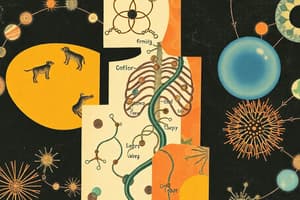Podcast
Questions and Answers
What is the main component from which steroid hormones are derived?
What is the main component from which steroid hormones are derived?
- Triglycerides
- Cholesterol (correct)
- Phospholipids
- Fatty acids
Which cellular organelle is primarily involved in the synthesis of protein hormones?
Which cellular organelle is primarily involved in the synthesis of protein hormones?
- Lysosome
- Mitochondria
- Ribosome (correct)
- Nucleus
Why are steroid hormones not stored in cells?
Why are steroid hormones not stored in cells?
- They are quickly degraded.
- They are not synthesized in cells.
- They are water-soluble.
- They are lipid-soluble and immediately released. (correct)
During the synthesis of protein hormones, what is the role of post-translational modification?
During the synthesis of protein hormones, what is the role of post-translational modification?
Which process describes the release of protein hormones from cells?
Which process describes the release of protein hormones from cells?
In the synthesis of peptide hormones, what happens immediately after transcription?
In the synthesis of peptide hormones, what happens immediately after transcription?
What is the role of the Golgi complex in hormone synthesis?
What is the role of the Golgi complex in hormone synthesis?
What characterizes a prohormone in the synthesis of protein hormones?
What characterizes a prohormone in the synthesis of protein hormones?
How do protein/peptide hormones travel in the body after their release?
How do protein/peptide hormones travel in the body after their release?
What is a significant trait of the membrane that influences peptide hormone permeability?
What is a significant trait of the membrane that influences peptide hormone permeability?
Which of the following are derivatives of the amino acid tryptophan?
Which of the following are derivatives of the amino acid tryptophan?
What is a characteristic feature of glycoprotein hormones?
What is a characteristic feature of glycoprotein hormones?
Which class of hormones is characterized by being derived from lipid components?
Which class of hormones is characterized by being derived from lipid components?
The hormone growth hormone is classified as what type of hormone?
The hormone growth hormone is classified as what type of hormone?
Which of the following is NOT a function of eicosanoids?
Which of the following is NOT a function of eicosanoids?
What type of hormones are known as short chain peptides and larger proteins?
What type of hormones are known as short chain peptides and larger proteins?
Which of the following statements about lipid-derived hormones is true?
Which of the following statements about lipid-derived hormones is true?
Identify which hormone falls into the category of glycoprotein hormones?
Identify which hormone falls into the category of glycoprotein hormones?
Which eicosanoid is known for playing a crucial role in inflammatory responses?
Which eicosanoid is known for playing a crucial role in inflammatory responses?
What is the primary component from which eicosanoids are derived?
What is the primary component from which eicosanoids are derived?
Flashcards
Hormone Classification: Chemical Structure
Hormone Classification: Chemical Structure
Hormones can be categorized based on their chemical structure. This classification helps understand how hormones function and interact with cells.
Amino Acid-Derived Hormones
Amino Acid-Derived Hormones
These hormones are derived from amino acids, specifically tyrosine and tryptophan. They play crucial roles in regulating various bodily functions.
Tryptophan-Derived Hormones
Tryptophan-Derived Hormones
These are hormones synthesized from the amino acid tryptophan. Examples include melatonin, which regulates sleep-wake cycles.
Tyrosine-Derived Hormones
Tyrosine-Derived Hormones
Signup and view all the flashcards
Peptide Hormones
Peptide Hormones
Signup and view all the flashcards
Glycoprotein Hormones
Glycoprotein Hormones
Signup and view all the flashcards
Lipid-Derived Hormones
Lipid-Derived Hormones
Signup and view all the flashcards
Eicosanoids
Eicosanoids
Signup and view all the flashcards
Protein Hormones
Protein Hormones
Signup and view all the flashcards
Growth Hormone
Growth Hormone
Signup and view all the flashcards
What are the basic steps in making a protein/peptide hormone?
What are the basic steps in making a protein/peptide hormone?
Signup and view all the flashcards
What does 'synthesis takes time' mean for protein/peptide hormones?
What does 'synthesis takes time' mean for protein/peptide hormones?
Signup and view all the flashcards
What are the differences between protein/peptide hormones and steroid hormones?
What are the differences between protein/peptide hormones and steroid hormones?
Signup and view all the flashcards
How are protein/peptide hormones released from cells?
How are protein/peptide hormones released from cells?
Signup and view all the flashcards
What is the role of vesicles in protein/peptide hormone storage and release?
What is the role of vesicles in protein/peptide hormone storage and release?
Signup and view all the flashcards
Why are protein/peptide hormones NOT freely permeable to cell membranes?
Why are protein/peptide hormones NOT freely permeable to cell membranes?
Signup and view all the flashcards
What is the role of the Golgi complex in protein/peptide hormone synthesis?
What is the role of the Golgi complex in protein/peptide hormone synthesis?
Signup and view all the flashcards
What is the primary precursor for steroid hormones?
What is the primary precursor for steroid hormones?
Signup and view all the flashcards
How are steroid hormones synthesized?
How are steroid hormones synthesized?
Signup and view all the flashcards
What is the difference between steroid hormone synthesis and protein/peptide hormone synthesis in terms of storage?
What is the difference between steroid hormone synthesis and protein/peptide hormone synthesis in terms of storage?
Signup and view all the flashcards
Study Notes
Hormone Classification
- Hormones are classified based on their proximity to the site of action (autocrine, paracrine, endocrine, neuroendocrine, pheromones) and chemical structure (proteins/peptides, steroids, amino acid derivatives, eicosanoids).
- Hormones with different chemical structures have different solubilities in aqueous media (hydrophobic or hydrophilic).
Hormone Derivatives of Tyrosine and Tryptophan
- Hormones are derived from the amino acids tyrosine and tryptophan.
- Examples of hormones derived from tyrosine include dopamine, noradrenaline, adrenaline. These are catecholamines.
- Examples of hormones derived from tryptophan include serotonin and melatonin.
Hormone Derivatives of Tryptophan - Detailed Pathway
- L-Tryptophan is the precursor.
- Tryptophan-5-hydroxylase converts L-Tryptophan to 5-Hydroxytryptophan
- 5-Hydroxytryptophan decarboxylase creates Serotonin
- Serotonin N-acetyltransferase (NAT) creates N-acetylserotonin
- Hydroxindole-0-methyltransferase converts N-acetylserotonin to melatonin.
Melatonin - Actions and Functions
- Melatonin has various actions including:
- Anti-inflammatory function
- Anti-oxidative function
- Immunomodulation
- Cardioprotection
- Neuroprotection
- Melanogenesis controller
- Metabolism regulator
- Fixing sleep dysfunction
- Circadian rhythm modulator
- Antineoplastic properties
Hormone Derivatives of Tyrosine - Detailed Pathway
- Tyrosine is the precursor.
- Tyrosine is converted to Dopa
- Dopa is converted to Dopamine
- Dopamine is converted to Noradrenaline
- Noradrenaline is converted to Adrenaline
Protein or Peptide Hormones
- Protein or peptide hormones consist of shorter chain peptides, larger proteins, and glycoproteins.
Peptide Hormone Example - Oxytocin
- Oxytocin is a peptide hormone
- Its structure is displayed in a diagram
Protein Hormone Example - Growth Hormone
- Growth hormone is a protein hormone.
- Its structure is displayed in a diagram
Glycoprotein Hormones - Structure and Subunits
- Glycoprotein hormones are a family of protein hormones with alpha and beta subunits.
- The alpha subunit is typically common.
- The beta subunit determines the specificity of the hormone.
- Examples include TSH, LH, EPO, hCG, and Inhibin
Lipid Derived Hormones - Cholesterol Derived Steroids
- These hormones are derived from cholesterol, and enzymes are located in mitochondria and the smooth ER.
- They are lipid soluble and are immediately released; they are not stored in cells.
- Examples include:
- Gonadal steroids (androgens, estrogens, progestins)
- Adrenocortical steroids (glucocorticoids like cortisol, mineralocorticoids like aldosterone)
Lipid Derived Hormones - Eicosanoids
- Eicosanoids are oxygenated fatty acids derived from either omega-3 or omega-6 fatty acids.
- They are lipid mediators.
- Subfamilies include prostaglandins (PGs), thromboxanes, and leukotrienes.
Chemical Structure Determines Hormone Properties
- Chemical structure influences the hormone's:
- Synthesis, Storage, Release
- Transport in Body Fluids
- Receptor Location
- Mechanism of Action
- Degradation
Hormone Synthesis and Storage - Protein/Peptide Hormones
- Protein/peptide hormones are synthesized in steps.
- These hormones are synthesized within the cell, then packaged into vesicles.
- Released on demand (by exocytosis from cells), and stored within the cell until needed.
Steps in Making a Protein/Peptide Hormone
- The process starts with gene transcription
- It moves through primary RNA transcription to post-transcriptional modification
- Moving through Messenger RNA to Prepeptide/Prepropeptide
- Followed by translation, post-translational modification
- Lastly, secretion of the mature (active) peptide hormone
Mechanisms of Protein Hormone Synthesis and Release
- Hormones are produced, processed and packaged in vesicles for release.
- Exocytosis of the hormones from cells results in proper hormone release
Hormone Synthesis and Storage - Steroid Hormones
- Steroid hormones are derived from cholesterol.
- Synthesized and immediately released, and not packaged into vesicles prior to release.
- Enzymes are found in the mitochondria and smooth endoplasmic reticulum
Steroid Hormone Synthesis Pathways
- The process displays a variety of chemical transformations of steroid hormones, from cholesterol through various intermediates to different steroids like testosterone and estrogen.
Steroids and Target Cell Activation
- Steroids are transformed to active steroids in target cells.
- Steroid hormones enter the target cells, where they bind to intracellular receptors, then enter the nucleus and affect gene expression.
Protein/Peptide vs Steroid Secreting Cells
- Diagram shows the differences in cellular structures of protein/peptide secreting cells versus steroid secreting cells.
- Different machinery and cellular features are shown in the diagrams to illustrate how hormones are synthesized, stored, and released appropriately using those systems.
Studying That Suits You
Use AI to generate personalized quizzes and flashcards to suit your learning preferences.
Related Documents
Description
Explore the classification of hormones based on their site of action and chemical structure. Dive deep into the derivatives of tyrosine and tryptophan, learning about key hormones like dopamine, serotonin, and melatonin. This quiz will enhance your understanding of hormonal pathways.




